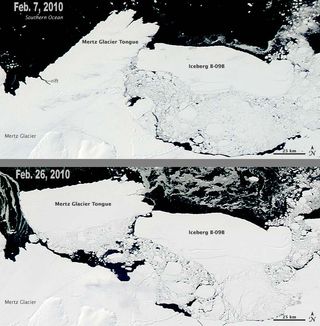Huge Iceberg Breaks Off Antarctica

At 58 x 24 miles (94 x 39 km), the B-09B iceberg, floating around Antarctica for more than two decades, is comparable to the state of Rhode Island.
And now in a slow-action but gargantuan collsion with Antarctica, B-09B has knocked another iceberg loose that is 48 x 24 miles in size.
After lingering near the Mertz Glacier in Eastern Antarctica for several years, the massive iceberg collided with the glacier tongue on Feb. 12 or 13, according to a statement from NASA. The giant frozen tongue broke away from the rest of the glacier.
New satellite images, released today, show the action.
The top image is from Feb. 7, 2010, when B-09B was approaching the Mertz Glacier Tongue. Chunks of sea ice float in the water between the smooth iceberg and the coast. It is clear that the iceberg and the glacier tongue are trapping the ice in place, NASA scientists explained.
The B9 iceberg broke from the Ross Ice Shelf in West Antarctica some time in 1987. It took the massive iceberg more than two decades to drift slowly out of the Ross Sea and along the coast to the Mertz Glacier in East Antarctica. B9 itself broke apart, with the massive portion called B-09B causing this most recent collision.
{{adsense|premier|left}}
Sign up for the Live Science daily newsletter now
Get the world’s most fascinating discoveries delivered straight to your inbox.
The ice tongue was an extension of the Mertz Glacier, created as the ice flows down the mountain and onto the water. Glacier tongues grow longer year by year until they eventually break off, calving a new iceberg. The Mertz Glacier Tongue was beginning to break before the B-09B iceberg rammed it. Dark horizontal cracks were visible in the ice tongue on Feb. 7.
Sometime on Feb. 12 or 13, B-09B struck the ice tongue. Clouds hid the event in MODIS satellite images, but on the afternoon of Feb. 13, the clouds had thinned just enough to reveal that the ice tongue had broken away in the collision. By Feb. 20 the glacier tongue had broken along the rifts that were visible in early February, NASA scientists say.
Over the course of the next week, the former Mertz Glacier Tongue pivoted away from the glacier like a door hinged at the point where B-09B hit it.
The iceberg formed from the Mertz Glacier Tongue is has a mass of 700-800 billion tons, the BBC News reported.
The glacier tongue had previously contributed to keeping a section of the ocean free of ice, a condition known as a polynya. The polynya provided a significant feeding site for wildlife like penguins. The shorter tongue may not protect the area from sea ice, reducing or even eliminating the polynya and the access to food it provided.

